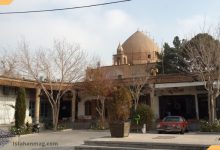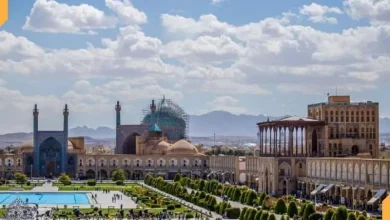Church of St. Joseph

One of the side entrances of the Amnapar Gitch Monastery which was in the traditional Iranian style took an Armenian identity with the addition of Armenian inscriptions, and with the addition of Bible paintings on the head at the entrance, found a Christian identity.
The bell tower and the clock that is located above the entrance of the monastery are in the traditional Iranian style. The bell tower was added to the building in 1931.
The facade of the library 1905-1906 has a combination of Iranian and European styles in its architecture and decorations.
This type of architecture is one of the common features of many buildings that were built in Iran in the early twentieth century. The view of Surp Amnapar Gitch Church and its bell tower from the northwest
The interior part of the church and the dome of the church of Surp Amnapar Gitch, which is completely covered with bricks, and its murals are in the Iranian style.
The dome is in Persian and Kombat (the ancient Armenian word meaning the ornate celestial roof) in Armenian.
Therefore, the dome, along with its decorations with the maze of a thousand streams, is an expression of religious thoughts that evoke the divine creation for the viewer.
The two decorative strips at the bottom of the church hall, which are made using a method that means seven colors in Persian, are exceptional examples of Persian tile art in the seventeenth century.
A decorative strip at the bottom of the multicolored plasterwork of the murals prevents premature deterioration of the undersides of the walls, which are usually more prone to erosion.
A view of the interior decorations of the church according to the tradition of Iranian architecture in the design of interior spaces are completely patterned or without any pattern.
The first option is used here. The integrity of the surface decorations is fragmented by strips of European-style pictorial paintings, often associated with important biblical stories or Armenian religious scenes.
Church of St. Joseph
Despite its small size, this church has a classical structure (domed hall). Two luxurious half-columns beautifully divide this interior space into two parts.
The western part, which is covered with a small dome and is for worshipers, and the eastern part, which is dedicated to the clergy, is located under a large dome (the wall that supports the dome).
The church is bounded on the east by two pentagonal recesses that are places of worship. The southern worship area also includes another room that, like other spaces attached to the south wall that can be accessed from inside the church, was used as a storage room for sacred objects. T
The interior is illuminated by windows that open to the east wall and the surrounding walls, but without a doubt, the greatest light comes from the eight vents on the stem of the dome.
In the early eighteenth century, a decorative column base with a length of 1.65 meters was added to the interior. This pillar base is made of ceramic tiles decorated with floral patterns in which blue and yellow colors are used as the main colors, and is a common example of decorative arts of that time.
At the top of this pillar and inside the church is decorated with reliefs of murals, ornaments, and sacred objects, from various styles of local Iranian to Persian Armenian and Western Armenian to completely European.
The reason for these Western influences was the constant contacts of Armenian merchants with Europe, especially Venice and Amsterdam, and the other was the presence of European artists in Isfahan for a long time so that even some of them remained in Isfahan forever.
Interior paintings depict scenes from the Bible (heaven and hell on the northwest wall) and the lives of saints (…). In addition, parts of the sacred events, the figures of angels, the crucified, and the image of the Holy Mother were depicted by the famous Armenian masters such as Minas, Simon, Tetanus, and Hovhannes Tizralus can be seen.
Some of the features of the components require special attention: the altar, which has very beautiful decorations, and the bishop’s throne both belong to the mid-nineteenth century. The separate curtains of the altar, which are decorated with very delicate and beautiful embroidery, are common elements in Armenian decoration and belong to the late nineteenth century.
The pure lines of the exterior of Joseph Church, which express the purity of the interior, are influenced by the exterior spaces and are characterized by a small bell tower belonging to the eighteenth century. All the walls are made entirely of brick and the decorative tile designs are shaped according to religious beliefs.
If you have an experience about this church, please write it for us. Which part of the church got you more amazed?







